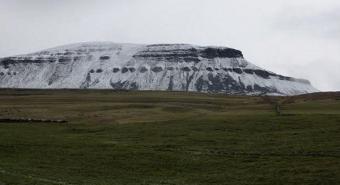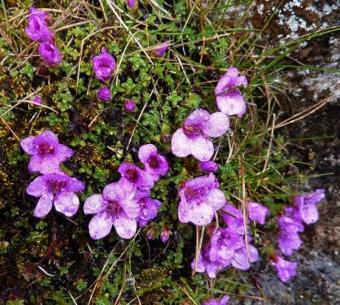 Snow Topped Pen-Y-Ghent
Snow Topped Pen-Y-Ghent
Snow was forecast for high ground as we departed for a trip to Ribblesdale but it was not long after we left Bradford that we hit a storm and as the landscape became white at low level we wondered what awaited us higher up. Fortunately the storm proved to be short-lived and before we reached Settle all signs of snow had disappeared.
Our first stop was at Stainforth where a small party of five disembarked for a walk in that area (of which more later) whilst the remaining nine proceeded to Horton for an expedition to see the purple saxifrage, an alpine plant which grows on the flanks on Penyghent – one of the few places in England where it can be found.
We started our walk in light rain but the clouds soon lifted to reveal an attractive snow-covered Penyghent. As we climbed higher the weather changed again and we encountered showers of snow and hail and by the time we had reached our destination at around 2000ft snow was lying on the ground. Our efforts, though, were rewarded with the sight of the saxifrage in flower and for Amanda and Sally a special treat as this was their first sighting of the rare plant.
Further dark clouds threatened as we ate our lunch under the limestone outcrop on which the plant grows and we were soon enveloped in another snowstorm but after that the weather brightened and as we made our way back to Horton we watched as the snow almost disappeared from Penyghent in the sunshine.
Bird life was sparse on the fell with only a few meadow pipits and no wheatear seen but a diversion to Hull Pot produced a brief sighting of a dipper near a previously recorded nesting place. Twenty one other birds, including raven, were recorded by Donald who also noted six plants in flower.
 Purple SaxifrageThis was a tough walk by BEES standards and although one or two found their fitness levels severely tested, all agreed that the effort had been worthwhile and we had enjoyed a very interesting day.
Purple SaxifrageThis was a tough walk by BEES standards and although one or two found their fitness levels severely tested, all agreed that the effort had been worthwhile and we had enjoyed a very interesting day.
Thanks to Robert for driving in sometimes demanding conditions.
Stuart
The five strollers left at Stainforth were ably led by Marilyn who stepped in in Margaret's absence. We ambled through some of the village before taking the route towards the Foss. The stone walls bordering the path were covered with a superb display of lichens. Many species had reproductive structures clearly visible eg.prominent apothecia like mini jam tarts on crustose lichens and clusters of funnel shaped podetia on Cladonia species. As always it was difficult to believe that some were living organisms and not daubs of paint. The Foss was pronounced impressive but not visitor friendly.
Nostalgia set in while watching a farrier working with modern technology out in the field rather than in a smithy as in our youth!
A visit to The Craven Heifer for an excellent lunch recharged our batteries after which we explored the churchyard, more lichens, and sauntered along paths and village streets before returning to the pub to await the minibus.
Plants in flower were sparse; finally twenty were recorded with Butterbur, Creeping Comfrey (most likely a garden escape) Danish Scurvygrass and Common Whitlowgrass being the most interesting. Five ferns were seen with Polypodies causing puzzlement as to species or was the second one a hybrid? Many opening buds and young leaves promise much to come.
A collared dove and a blackbird are all I recollect for the bird count!
The new venture of offering an alternative walk to the main more strenous one was appreciated.
Alice.
PS. This is my first blog. Constructive criticism will be welcomed!
See the photos here.
